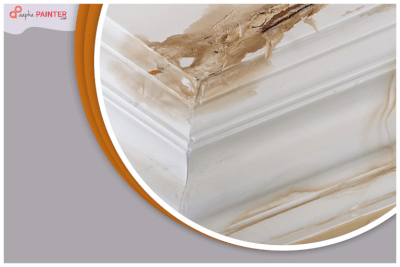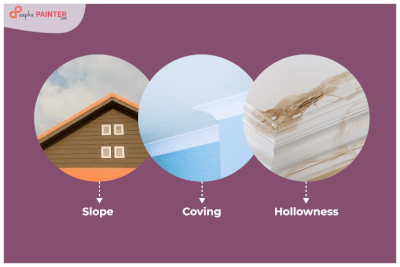Table of Contents
Importance of Slope, Coving and Hollowness Repair in a Roof
You might not know this, but the roof is constantly exposed to eroding, corrosion, and other damaging factors. It can be a tree branch that suddenly fell on the roof and blocked the vent of the attic room or constant heat exposure damaging the wooden shingles you have used on the roof.
Since it is so vulnerable and has to endure the wrath of weather and climatic conditions, you cannot expect the roof tiles and shingles to be in proper condition after years.
They are bound to get damaged. Any sign of damage to the roof is a clear indication of a repair call. Replacing the tiles or shingles isn’t the only option by which you can fix a damaged roof Waterproofing.
There are several other ways to repair this particular part of your house or, in other words, the most important part. The most important repairing methods being followed in the construction industry are hollowness repair, coving repair, and slope repair. This article will introduce these three types and related facts about them.
Our guide will help you differentiate between the repairing methods and understand which one will be suitable for the damage your roof has suffered.
How to know if the roof needs repairing?

The first and foremost thing you need to know is when your roof needs repairing. Most people cannot understand this basic need and call the repair professional so late that the charges incurred are quite huge. This is why you should look for the signs of your roof damage. This will allow you to identify the problem and call the roof repair company on time.
In the below section, we have described certain factors that indicate a damaged roof Waterproofing .
- One of the primary symptoms of roof damagea is water leaks. The roof protects us from weather conditions, especially rain and snow. But if you can see the water slowly dripping from the ceiling, it means the roof has holes and cracks, allowing the water to pass through.
- Another symptom of roof damage is moldy growth. Since this is a microorganism, you won’t be able to see its physical presence. But a pungent smell and greenish spots on the ceiling indicate mold has started to grow. It usually happens when the roof allows water to pass through, and the concrete inside absorbs the water.
- The roofing materials are so porous that they absorb moisture in highly humid areas. As a result, the ceiling and the surrounding walls show signs of dampening. It is also another symptom of roof damage.
- Lack of temperature insulation sometimes indicates the roof shingles are damaged and have large holes. Due to the open space, air and heat transfer can easily happen between the house’s interiors and the atmosphere.
What are the three major forms of roof repair process?

Since you now know the major signs of roof damage from the above section, it’s time to focus on the major types of roof repair processes. This section will briefly explain the three processes to ensure you can easily identify them without any hassles.
- Coving repair
The junction between the roof and the walls are known as coving. It mainly gets damaged from dampened ceilings and walls, cracks in the surface, moisture absorption in the concrete, and so on. There are several ways in which a damaged coving can be repaired. Some of these are:
- One of the most common ways of coving repair is to fill the cracks and small holes with injection grouting or apply a thick paste of white plaster and primer. This is suitable only when the coving area is plain, and the ceiling and walls are perpendicular to each other.
- Another way is to remove the damaged coving part and scrape the residual materials sticking to the ceiling or the wall. This is suitable only for coving with décor items. Once done, clean the area using sanding paper and apply a fresh layer of plaster. Let it dry, then smoothen the area to get a uniform surface. Now install the coving part you have ordered, and it should be an exact match with the existing coving design.
- Sometimes, the coving has minute cracks and microscopic holes. In this case, removing the entire coving and starting the process from scratch is unnecessary. Instead, you can use wood filler or injection grout to fill the holes and cracks.
- If there are gaps between two parts of the coving, use sand or wood filler to fill the open space and apply the plaster.
- Hollowness repair
Waterproofing : If your roof is made from shingles, some of them may come off, creating a hollow space and exposing the interiors. The same happens when a flat roof made from concrete has a large and wide crack due to erosion and mechanical abrasion. This is more serious damage and requires urgent addressal.
If you leave the hollow as it is or only do temporary patching work, you might have to face several other waterproofing problems, like rain pouring down from the hollow space and so on. Waterproofing services are available.
This is why you need to install new shingles to cover the hollow space on the roof. In case the hollow has been created in one shingle only, you need to replace that shingle itself. For smaller holes, the filling will be the best option. You can use sand or wood filler from the inside and then apply plaster to make the surface smoother. Outside, a thick plate is placed over the hollow area to cover it.
- Slope repair
If the roof damage is due to its slope, the best way to repair the issue is to correct the slope. Unless and until the roof has a proper slope, rainwater will clog, and the chances of further damage are more. This is why most roofing contractors correct the roof’s slope by applying layers of concrete and aggregate mix.
Conclusion
In this article, we have walked you through the best ways in which different roof and ceiling problems can be solved easily. However, these problems require professional input. So, you need to ensure you call the best roofing contractor who can repair the issue and restore the original condition of the roof without any further Waterproofing problems.
